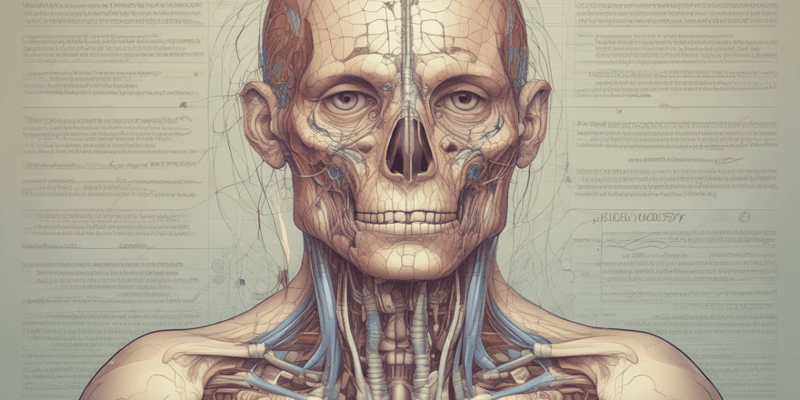Podcast
Questions and Answers
What is the function of the esophagus?
What is the function of the esophagus?
What is the role of the trachea?
What is the role of the trachea?
Where is the laryngopharynx located?
Where is the laryngopharynx located?
What are palatine tonsils?
What are palatine tonsils?
Signup and view all the answers
What is the function of the uvula?
What is the function of the uvula?
Signup and view all the answers
What is the nasopharynx?
What is the nasopharynx?
Signup and view all the answers
What are pharyngeal tonsils commonly known as?
What are pharyngeal tonsils commonly known as?
Signup and view all the answers
What is the sphenoid sinus?
What is the sphenoid sinus?
Signup and view all the answers
What is the function of the frontal sinus?
What is the function of the frontal sinus?
Signup and view all the answers
What do the superior, medial, and inferior nasal conchae do?
What do the superior, medial, and inferior nasal conchae do?
Signup and view all the answers
What is the vestibule in relation to the nasal cavity?
What is the vestibule in relation to the nasal cavity?
Signup and view all the answers
What are nostrils?
What are nostrils?
Signup and view all the answers
What is the hard palate?
What is the hard palate?
Signup and view all the answers
What is the soft palate?
What is the soft palate?
Signup and view all the answers
What is the function of the tongue?
What is the function of the tongue?
Signup and view all the answers
What are lingual tonsils?
What are lingual tonsils?
Signup and view all the answers
What is the hyoid bone?
What is the hyoid bone?
Signup and view all the answers
What is the epiglottis?
What is the epiglottis?
Signup and view all the answers
What are vestibular folds?
What are vestibular folds?
Signup and view all the answers
What is thyroid cartilage?
What is thyroid cartilage?
Signup and view all the answers
What is the function of vocal folds?
What is the function of vocal folds?
Signup and view all the answers
What is cricoid cartilage?
What is cricoid cartilage?
Signup and view all the answers
What is the role of the thyroid?
What is the role of the thyroid?
Signup and view all the answers
Study Notes
Upper Respiratory Tract Structures
-
Esophagus: Tube connecting the throat (pharynx) to the stomach, important for food passage.
-
Trachea: Windpipe that provides a passage for air to reach the lungs, composed of rings of cartilage.
-
Laryngopharynx: Lower part of the pharynx, situated behind the larynx, it serves as a pathway for both air and food.
-
Palatine Tonsils: Lymphoid tissues located on both sides of the throat, play a role in immune response.
-
Uvula: Small, hanging structure at the back of the throat, aids in speech and prevents food from entering the nasal cavity.
-
Nasopharynx: Upper part of the pharynx located behind the nasal cavity, connects nasal passages with the throat and houses adenoid tissues.
-
Pharyngeal Tonsil: Lymphatic tissue located in the nasopharynx, part of the immune system, helps capture pathogens.
-
Sphenoid Sinus: Air-filled spaces within the sphenoid bone, located behind the nasal cavity, contribute to voice resonance and reduce skull weight.
-
Frontal Sinus: Pair of air-filled spaces located above the eyes in the frontal bone, involved in mucus production and drainage.
-
Superior, Medial, and Inferior Nasal Conchae: Bony structures in the nasal cavity, responsible for increasing surface area, humidifying, and filtering inspired air.
-
Vestibule: The anterior portion of the nasal cavity, acts as the first entrance for air and contains hair and skin for filtration.
-
Nostrils: External openings of the nose, allowing air to enter and exit the respiratory system.
-
Hard Palate: Bony structure forming the roof of the mouth, separates the nasal cavity from the oral cavity.
-
Soft Palate: Muscular and flexible portion at the back of the roof of the mouth, important for swallowing and speech.
-
Tongue: Muscular organ in the mouth, crucial for taste, swallowing, and speech production.
-
Lingual Tonsils: Lymphoid tissue located at the base of the tongue, part of the immune system.
-
Hyoid Bone: U-shaped bone in the neck that supports the tongue and aids in swallowing.
-
Epiglottis: Flap of cartilage at the root of the tongue, prevents food from entering the windpipe during swallowing.
-
Vestibular Fold: Also known as false vocal cords, located above the true vocal cords, involved in protecting the airway.
-
Thyroid Cartilage: Largest cartilage in the larynx, also known as the Adam's apple, provides protection for the vocal cords.
-
Vocal Fold: True vocal cords located within the larynx, responsible for sound production by vibrating as air passes through.
-
Cricoid Cartilage: Ring-shaped cartilage located below the thyroid cartilage, provides support and maintains the airway structure.
-
Thyroid: A hormone-producing gland located in the neck, plays a vital role in metabolism and growth.
Studying That Suits You
Use AI to generate personalized quizzes and flashcards to suit your learning preferences.
Description
Test your knowledge of the upper respiratory tract with our labeling quiz. You'll identify key parts like the esophagus, trachea, and tonsils, enhancing your understanding of human anatomy. Perfect for students studying respiratory systems in biology.




